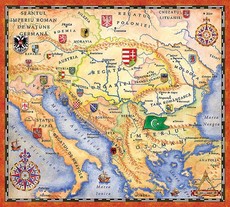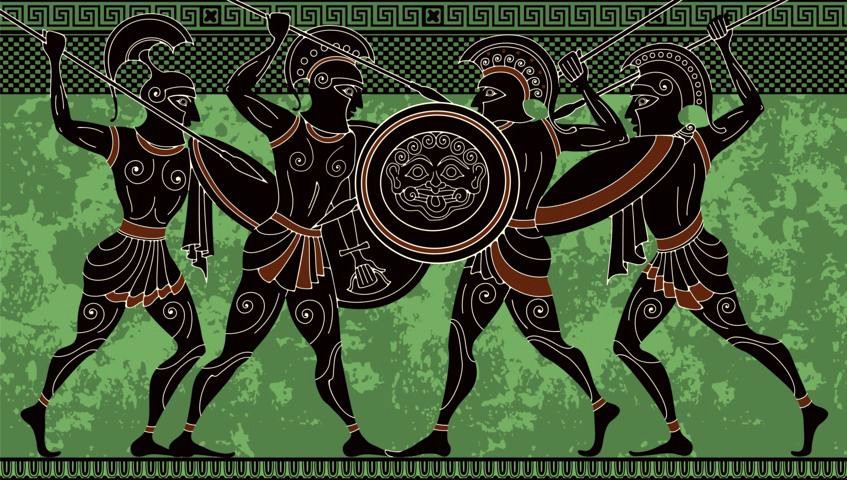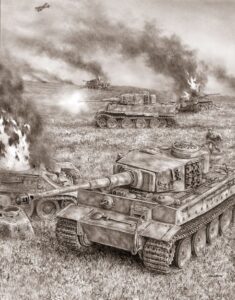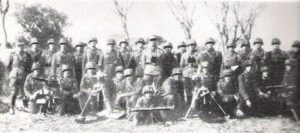The history of the Teutonic Knights is mainly related to the crusade in Eastern Europe and Prussia but this order, which originated in the Holy Land after the Templars and Hospitallers has also been active in the Mediterranean area and in Transylvania, which after World War II was incorporated into Romania but until 1945 belonged to Hungary and was for a long time a borderland between the Christian world the pagan Slavic one and the Ottoman Turks, even today this land is inhabited by a strong Hungarian minority while the Germans, known as Transylvanian Saxons, were expelled from it after 1945 .
Hungary was situated between the Holy Roman Empire and the Byzantine Empire and was an important political factor for both was driven by a desire to expand eastward to obtain the natural resources of Transylvania called the land beyond the forests, the Hungarians initially settled in the western part of the region where salt deposits were located, this was the area of Somesu in the Mures region, in 1003 Stephen the 1st of Hungary called the Saint conquered this land and King Ladislaus moved the border further to oriete, in 1100 the Hungarians advanced to Olsul but the slopes of the Carpathians were reached in the early next century conquering all of Transylvania.
To defend the borders of this region border guards were created i.e. armed peasants who as a reward received personal and family freedom, among them the most important were the Siculi of Transylvania who had nothing to do with those of Sicily, during the second crusade, in 1147, Emperor Conrad III° of Swabia with his army crossed Hungary bound for the Holy Land and met with King Geza II°, it was on this occasion that an agreement was reached concerning the colonization of Transylvania, the Germans began to arrive in the middle of the 12th century and with the passage of time and new territorial conquests the borders reached the slopes of the Carpathians, so with the annexation of all of Transylvania Hungary dominated the entire Danube basin up to the border with the kingdom of Serbia and Transylvania was called Siebenburgen ( seven mountains) by the Germans, the Hungarians settled in the plain while the Germans, also called Transylvania Saxons, and Siculians were at the mountains , the Germans were in the Broos and Draas regions and according to a document of 1224 enjoyed all privileges. But Geza II ° intended to fortify the border by giving it to the Germans however the region to the southeast had not yet been colonized, so the Cumaean people continued to make forays into Transylvania by passing through the
Carpathians to invade Hungary itself and then to head west, Hungary’s King Andrew II ° tried to stem these invasions by settling Hungarian nobles in the territory in addition to the Transylvanian Saxons, but they did not have sufficient numbers of armed men to protect it and preferred to remain within the kingdom.
The Cumans were nomads , shepherds and warriors linked to the Selgichid Turks and had invaded Moldavia and Wallachia several times, also attacking the Byzantines and Kievan Russians, they were pagans and lived in tents and used mainly bows and arrows for combat, they were defeated several times by the Hungarians and Kievan Russians but under Andrew II° Transylvania also known as Burzenland was semi-inhabited and always under constant threat of Cuman invasions. The ruler wanted to Christianize the region, but in addition to the Saxons, a military force capable of expanding and defending the southeastern Carpathian area from the Cumans was needed in addition to carrying on the work of evangelization.
The king had contacts with Count Hermann of Thuringia, who included among his vassals the family of the grand master of the Teutonic Order Hermann von Salza, and he had made the marriage contract between his daughter Elizabeth ( future patroness of the Secular Franciscan order) and Ludwig future Count of Thuringia, when the Hungarian king told him of his intention to lead a crusade he mentioned the problem he had with the Cumans and his desire to expand the kingdom southeast of the Carpathians, and the Count of Thuringia suggested that he make use of the Teutonic Order which then had Hermann von Salza as grand master, these knights could protect the Hungarian frontier and give the king the opportunity to go to the Holy Land.
By now the Teutonic knights had made a name for themselves and were praised by many rulers, and the order had obtained large donations, but only under the leadership of von Salza had they become very close to the emperor and the popes, the Hungarian king had also heard about the order from his wife and so he wrote to Count Hermann of Thuringia asking for the Teutonic Knights to come to Transylvania so that he could protect the territory from the Cumans by promising them the lands of Barcasag in eastern Hungary specifically in Burzenland which is now the present Brasov district in Romania, the Teutonic Knights could build towns and castles, they would have immunity from taxes and duties and granted the order the power to perform their religious functions and collect tithes which meant that the order could take settlers with them and support themselves with their rent and labor without having to pay tribute to the king, in practice the whole of Transylvania was handed over to the order but the king retained the right to mint coinage and obtain half of the gold and silver found in the mines although he gave up taxes and tolls and the ability to establish markets, in addition the knights were not required to host the voivode and could exercise justice, in return they had to protect the frontier from the Cumans, convert them to Catholicism and if possible expand Hungarian territory beyond the Carpathians.
Hermann von Salza was glad of the possibility of establishing a territory dominated by his order at a time when its holdings were very fragmented and this was necessary so in 1211 he accepted the Hungarian king’s request with the assumption that relations with him would improve further in the future but the land he was given was bare and depopulated and its boundaries went from Halmagin to the village of Galt and from there through the mountains of Mikloschwar along the old river to the mouth of the Prejmer and then into the mountains to the headwaters of Tomosch and Brsa and over the rocky hills to the borders of the territory.
The first contingent of Teutonic knights was led by a certain Theuderic and the vow was the same as in the Holy Land i.e., to fight the pagans and convert them, this unit traveled all over the territory until it marked the borders.
The Teutonic knights built a series of wooden fortifications along the border and began to evangelize and colonize by bringing in peasants from Germany who would cultivate the land and pay the necessary taxes for the garrisons and fortifications , they built the Marienburg castle across the Tarlaue River then the Kreuzburg castle, Gespremberg near Brasov, the mountain one of Rosenau and near Zieden the one of Schwarzburg, the castles also served for civil administration, other fortresses were built for defensive purposes , with their presence the incursions of the Cumans were reduced so in 1212 Andrew II th increased the donations of the order by granting to build the city of Kreuzburg plus other tax exemptions. The Teutonic knights could demand taxes from all but the Hungarians, but the king’s concessions were rather vague and imprecise, and the Teutonic knights in Burzenland not only defended the frontier from attacks by the Cumans but occupied other lands across the border.
By 1220 they had already built seven cities and German colonists had settled there especially at Hermannstadt ( Sibiu) while next to Kronstadt ( Brasov) castle four others were built with names of Prussian ones : Marienburg, Schwarzenburg, Rosenau, and Kreuzburg, Marienburg became the symbol of Teutonic power in Hungary and was the basis for further expansion into the land of the Cumans, but this growth of Teutonic power aroused jealousies and rivalries with the Hungarian clergy and nobility because of future expansion activities to and beyond the Danube and
the Latin empire of Constantinople, the king of Hungary was angered by the abuses committed by the knights but made further concessions including the export of goods from abroad and exemption from duties.
The Hungarian nobility realized that the Cumans were no longer a danger but the growing Teutonic power was and a strong anti-German party formed and urged the king to resist the further demands of the knights by accusing them of dishonesty and of having exceeded the donations and privileges granted, however, they lacked a personality such as von Salza who could smooth out the differences, the Hungarian nobles thought that the king had allowed the establishment of an autonomous duchy within the kingdom and accused the knights of exceeding the limits granted to them, the Hungarian king had returned from the crusade embittered while von Salza was elsewhere, so the Hungarian nobility forced the king to issue the Golden Bull, a document similar to the English Magna Charta by which they demanded a review of the concessions to the Teutonic knights, von Salza despite his connections at court and with the pope could not influence the Hungarian nobles supported by the heir designate Bela, in 1224 the papacy subjected the Burzenlad to its protection through the work of von Salza thus breaking the ties between the knights and the Hungarian crown , however the king understood the danger and retracted all concessions made and ordered the knights to leave Hungary, at the refusal of the Teutons a Hungarian army led by Prince Bela marched into Burzenland and the knights had to negotiate surrender and they were driven out of the kingdom and their castles destroyed, only the peasants known as the Saxons of Transylvania remained in those lands until 1945, the removal of the knights led to a resumption of the Cuman raids and for the Teutons the crusade into Prussia opened up that would characterize the rest of their history





